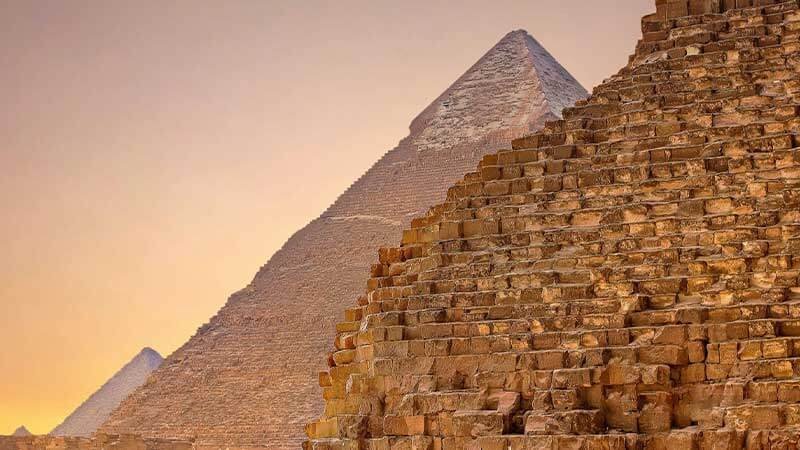The Pyramid of Menkaure, also known as the Pyramid of Mykerinos, stands proudly on the Giza Plateau in Egypt alongside its renowned counterparts: the Great Pyramid of Khufu and the Pyramid of Khafre. This majestic wonder has intrigued historians, archaeologists, and tourists for centuries, offering a glimpse into the rich history of ancient Egypt and captivating the world with its enigmatic allure.
Don’t forget to read our related blogs:
Unveiling the Historical Tapestry

Constructed during the Fourth Dynasty of the Old Kingdom of Egypt, approximately between 2532 and 2504 BCE, the Pyramid of Menkaure was intended as the final resting place for Pharaoh Menkaure, also known as Mykerinos. Despite being the smallest of the Giza pyramids, its historical significance is monumental, representing the zenith of pyramid-building achievements during this era.
Architectural Splendor and Design
Once a towering architectural marvel, the Pyramid of Menkaure reached an impressive height of around 65 meters (213 feet) and boasted an original base measuring approximately 108.5 meters (356 feet) on each side. Its exterior was adorned with polished Tura limestone, reflecting the brilliant Egyptian sun. Although much of the outer casing has vanished, remnants still offer glimpses of the pyramid’s former glory.
The Art of Construction
The construction of the Pyramid of Menkaure showcases the innovative techniques employed by ancient Egyptian architects. Limestone blocks, meticulously cut and transported to the site, were stacked in layers, creating the pyramid’s smooth and imposing exterior. Within the pyramid’s labyrinthine interior, a complex network of passages, chambers, and corridors served as the eternal resting place for the pharaoh.
The Sphinx Connection
Adjacent to the Pyramid of Menkaure lies the iconic Great Sphinx, a creature with a lion’s body and a human’s head. The Sphinx’s profound connection to the pyramid has fueled numerous speculations and theories. Some suggest that the Sphinx was the pyramids’ guardian, while others propose deeper, more intricate relationships between these two enigmatic structures.
Symbolism and Purpose
The Pyramid of Menkaure holds immense historical and cultural significance, shedding light on ancient Egyptian funerary practices and beliefs. Like its larger counterparts on the Giza Plateau, it was meticulously constructed to ensure the safe passage of the pharaoh’s soul into the afterlife. The pyramid’s interior chambers were filled with precious artifacts and offerings meant to assist the pharaoh in their journey to the realm of the gods.
Journeying through the Chambers

Exploring the Pyramid of Menkaure unveils its complex interior structure, featuring chambers like the King’s Chamber and the Queen’s Chamber. The King’s Chamber, at the pyramid’s heart, houses the pharaoh’s sarcophagus, while the Queen’s Chamber is believed to serve a symbolic rather than a burial function. This interior layout differs from the Great Pyramid of Khufu, reflecting the evolution of architectural techniques and concepts.
The Pyramid Complex
The Pyramid of Menkaure is not merely a standalone structure; it is part of an extensive complex that includes a mortuary temple, a causeway, and smaller pyramids for royal family members. The mortuary temple served as a place for funerary rituals and prayers for the pharaoh. At the same time, the causeway connected it to the Valley Temple, likely used for the pharaoh’s mummification process. This comprehensive layout underscores the meticulous planning of ancient Egyptian architects.
Legacy and Endurance
Over centuries, the Pyramid of Menkaure has stood as a testament to the greatness and ingenuity of ancient Egypt. It has weathered the test of time, witnessing the ebb and flow of empires and inspiring awe in countless visitors. As one of the best-preserved ancient structures, it continues to remind us of the advanced architectural prowess of the ancient Egyptians.
Frequently Asked Questions
Is the Pyramid of Menkaure open to visitors?
Yes, the Menkaure Pyramid, along with the other Giza pyramids, is open to visitors, allowing them to explore both the exterior and, in some cases, the interior.
What artifacts were found inside the Pyramid of Menkaure?
Archaeologists have uncovered various artifacts within the pyramid, including a granite sarcophagus, funerary goods, and precious offerings meant to accompany the pharaoh into the afterlife.
How long did it take to build the Pyramid of Menkaure?
The construction of the Pyramid of Menkaure likely spanned several decades and involved the labor of thousands of skilled workers.
What is the significance of the Pyramid of Menkaure’s smaller size than the other Giza pyramids?
Despite its smaller size, the Pyramid of Menkaure holds equal importance and symbolic value to its larger counterparts, reflecting changing priorities and available resources during the Fourth Dynasty.
Has the interior of the Pyramid of Menkaure been fully explored?
While much of the pyramid’s interior has been studied, some areas remain restricted to preserve the ancient structure and protect valuable artifacts.
What is the role of the Pyramid of Menkaure in modern times?
Today, the Pyramid of Menkaure remains a prominent historical and cultural landmark, attracting tourists worldwide and serving as a reminder of the rich heritage of ancient Egypt.
Conclusion
The Pyramid of Menkaure stands as a timeless testament to ancient Egypt’s grandeur, brilliance, and profound beliefs. Its construction signifies the dedication and ingenuity of ancient architects, while its role as a funerary monument underscores the profound significance of the afterlife in Egyptian culture. As it continues to inspire awe and admiration, this iconic structure reminds us of the enduring greatness of civilizations long past.


